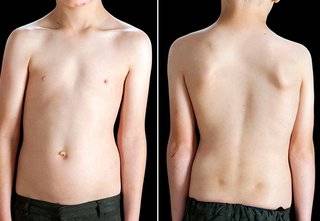Preventing Scoliosis: Strategies for a Straighter Spine
Introduction:
Scoliosis is a condition characterized by an abnormal curvature of the spine, often presenting as an "S" or "C" shape when viewed from the back. While some cases of scoliosis are congenital or develop due to factors beyond our control, there are proactive measures individuals can take to reduce the risk of scoliosis or prevent its progression. In this comprehensive guide, we will delve into various strategies and lifestyle adjustments that can aid in preventing scoliosis, promoting spinal health, and maintaining proper posture.
Understanding Scoliosis:
Before delving into prevention strategies, it's crucial to understand the different types and causes of scoliosis. Scoliosis can be broadly categorized into three types:
1. Idiopathic scoliosis: This is the most common type, accounting for about 80% of cases. Idiopathic scoliosis develops without a known cause and typically manifests during adolescence.
2. Congenital scoliosis: This type occurs due to abnormal spinal development in the womb. It is present at birth and can worsen as the child grows.
3. Neuromuscular scoliosis: Neuromuscular conditions such as cerebral palsy or muscular dystrophy can lead to muscle weakness or imbalance, resulting in scoliosis.
While some risk factors for scoliosis, such as genetics or congenital abnormalities, cannot be modified, there are steps individuals can take to reduce the likelihood of developing or exacerbating the condition.
Prevention Strategies:
1. **Maintain a Healthy Weight:**
Obesity and excessive weight gain can place added stress on the spine, potentially contributing to spinal curvature abnormalities. Maintaining a healthy weight through a balanced diet and regular exercise can help reduce this risk.
2. **Regular Exercise and Physical Activity:**
Engaging in regular physical activity is vital for overall health, including spinal health. Exercises that promote core strength, flexibility, and muscle balance can help support the spine and reduce the risk of developing scoliosis. Yoga, Pilates, swimming, and strength training are excellent options for improving posture and spinal alignment.
3. **Practice Good Posture:**
Poor posture can strain the muscles and ligaments supporting the spine, leading to spinal misalignment over time. Encouraging good posture habits from a young age and being mindful of posture during daily activities can help prevent the development of scoliosis. Sitting and standing up straight, avoiding slouching, and maintaining ergonomic workstations are essential for spinal health.
4. **Use Ergonomic Furniture and Equipment:**
Ensuring that furniture and equipment, such as chairs, desks, and mattresses, are ergonomically designed can support proper spinal alignment and reduce the risk of developing spinal curvature abnormalities. Ergonomic adjustments can help distribute body weight evenly and alleviate pressure on the spine.
5. **Avoid Prolonged Sitting or Standing:**
Prolonged periods of sitting or standing can place strain on the spine and contribute to postural imbalances. It's essential to take regular breaks, stretch, and change positions throughout the day to prevent muscle fatigue and maintain spinal health.
6. **Quit Smoking:**
Smoking has been linked to an increased risk of developing spinal conditions, including degenerative disc disease and reduced bone density. Quitting smoking can improve circulation, promote tissue healing, and reduce inflammation, benefiting overall spinal health.
7. **Stay Hydrated:**
Proper hydration is essential for maintaining the elasticity and strength of spinal discs, which act as cushions between the vertebrae. Drinking an adequate amount of water throughout the day can help keep spinal discs hydrated and reduce the risk of disc degeneration.
8. **Regular Spinal Screenings:**
Regular check-ups with a healthcare professional, such as a primary care physician or chiropractor, can help identify spinal abnormalities early on and facilitate timely intervention or treatment if necessary. Spinal screenings are especially important for children and adolescents during periods of rapid growth and development.
9. **Use Proper Lifting Techniques:**
Incorrect lifting techniques can place strain on the spine and increase the risk of injury. When lifting heavy objects, it's essential to bend at the knees, keep the back straight, and use the legs to lift rather than relying solely on the back muscles.
10. **Wear Supportive Footwear:**
Wearing supportive footwear with adequate arch support can help maintain proper alignment of the feet, which can have a cascading effect on overall posture and spinal health. Avoiding high heels or shoes with inadequate support can reduce the risk of postural imbalances.
Conclusion:
While scoliosis cannot always be prevented, adopting healthy lifestyle habits and proactive measures can significantly reduce the risk of developing spinal curvature abnormalities and promote overall spinal health. By maintaining a healthy weight, engaging in regular exercise, practicing good posture, and seeking appropriate medical care, individuals can take control of their spinal health and enjoy a life with a straighter, stronger spine. Remember, prevention is key, and investing in spinal health today can pay dividends for years to come.


